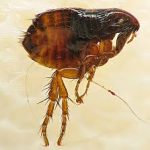Why Is My Ferret Anemic? What Causes The Anemia And What Can Be Done
Ron Hines DVM PhD
 Link To Ferret Health Care Library
Link To Ferret Health Care Library
Read in more detail about the anemia that un-neutered and non bred female ferrets suffer in my article on spaying and neutering ferrets here.
Why Would My Ferret Become Anemic?
Anemia is a rather common problem in ferrets. There are a number of conditions that cause it.
Simple Causes:
 Fleas
Fleas
If you are very fortunate, the problem is fleas. Dog and cat fleas are quite happy to feast on ferrets. The ferrets habits of burrowing into clothing and stuffed furniture give fleas unlimited opportunity once they are present in your home. If you see fleas on your cats and dogs, your ferret has them as well. Read about fleas on dogs and cats and ferrets here. It does not take long for fleas to suck a good portion of the blood out of your ferret – leaving it anemic. Any product that can safely be applied to kittens can be applied to your ferret to solve this problem. Also, run all bedding through a hot cycle in the washer and dryer to eliminate fleas. Two of the most effective products are Advantage® or Frontline® or their generic equivalents
 Diet:
Diet:
Ferrets that are eating a quality ferret diet should not develop anemia. But if they are being fed dog food or some brands of cat food, they may not be getting the nutrients they need to produce blood. You will find some good sources of ferret food in another article that you can read here.
Exposure to Zinc, Galvanized Wire or Utensils
Ferrets that are kept in galvanized wire cages or cages with galvanized floor trays may ingest too much zinc. The first sign of this is usually anemia. It can also occurs in ferrets that have eaten small items that contain zinc – although these pets usually show more rapid signs of intestinal obstruction.
More Problematic Causes Of Anemia
Ferrets can also become anemic due to a number of specific diseases.
Adrenal Gland Tumors:
One of the common signs of adrenal gland tumors in ferrets is anemia. This is due to over-production of estrogens which prevent the pet’s bone marrow from producing red blood cells.
Estrogen-induced Aplastic Anemia
Unspayed female ferrets also develop anemia if they are not bred. This is a form of aplastic anemia caused by too much circulating estrogen. It is no longer common because most female ferrets are spayed by the breeders before they are sold. When it was common, the pets needed transfusions and hormone therapy. By the time I saw most of them, they were so anemic (less than 20% PCV) that they rarely survived. Injections of human chorionic gonadotropin occasionally works to ovulate these ferrets and cure them until their next heat cycle. But by the time they are anemic, they are usually too weak to breed. Read extensively about that problem in intact, non-breeding female ferrets here.
Lymphoma – Lymphosarcoma
Lymphatic Tumors are very common in ferrets of all ages. One of the signs of this problem is anemia. Enlarged lymph nodes and an elevated blood lymphocyte count sometimes accompany this disease as do an enlarged spleen and weight loss. But both have other causes that are unrelated to cancer. These tumors do not respond well to chemotherapy or radiation.
Intestinal Hemorrhage:
Stressful situations that cause repeated bloody diarrhea or stools will eventually cause anemia. The stool is described as “black and tarry”. Some of these cases are due to feeding raw chicken and meat, containing bacteria such as Campylobacter or Salmonella. Infection with Helicobacter mustelae is also thought to occasionally cause anemia in ferrets. Others are due to excessive heat and in some cases we do not know the cause.
Kidney Failure:
When a pet’s kidneys fail, they lose the ability to produce erythropoetin which is necessary for blood formation. In kidney (renal) failure, poisons also build up in the pet’s blood that prevent new blood cells from being formed (another form of aplastic anemia). Blood tests can quickly spot this problem.
Other Cancers:
Almost all malignant tumor liberates chemicals that suppress the body’s ability to produce blood.
Pure Red Cell Anemia (PRCA) and Autoimmune Anemias
There is little known about these conditions in ferrets. However, an article was published in 2010 on a probable case of pure red cell anemia in a ferret that was apparently cured through a specific treatment plan. You can read that article (ask me for Shachar Malka 2010) Perhaps some of the perplexing cases of anemia that veterinarians see in ferrets, can have successful outcomes.
Aleutian Disease
Aleutian disease is caused by a type of parvovirus that attacks members of the weasel family, including mink and ferrets. One of the many signs of Aleutian Disease when it attacks ferrets can be anemia. Basically, in this condition, the ferrets just go “down hill” with no specific signs. There is a blood test (CIEP-test) to diagnose it. This disease is not common in ferrets in the United States.
How Can I Tell If My Ferret Is Anemic?
Anemic ferrets must breathe faster to keep their bodies oxygenated. A normal ferret takes about 20–36 breaths per minute.
A normal ferret’s heart beats about 180–250 beats per minute. The average is about 225 beats per minute. If a resting ferret is breathing faster than that, it may be over-heated, anemic or upset.
Anemic ferrets have low energy levels. They sleep more than normal and don’t have the curiosity they once had. They don’t groom themselves as well, and they often lose weight due to a poor appetite.
The gums of anemic ferrets are very pale. You will see that the gums or mucous membranes are pale when you lift your ferret’s lip. Its eyes and ears may be pale as well. These areas may also be yellowish in color.
Anemic ferrets usually have heart murmurs that are audible with a stethoscope.
Anemic ferrets may bleed longer than normal ferrets. That is, their blood may take longer to clot.
How noticeable these signs are in your ferret depends on how anemic it is and how quickly the anemia occurred. With gradual blood loss anemia, the body has the time to adjust to the decreased red blood cell numbers. But ferrets that become anemic very quickly can die because their bodies just can’t handle their sudden loss in red blood cells and their resulting lack of oxygen.
How Will Your Veterinarian Diagnose Anemia In Your Ferret?
Determining that your ferret is anemic is quite simple. Determining the cause can be much harder.
The simple tests (PCV, Hct) can be run while you wait. Anemias are divided into two types. In the first, blood is being lost somewhere, (regenerative anemia). In the second, aplastic anemia, the pet’s bone marrow is not making any red blood cells. We decide which is occurring based on the results of blood tests sent to a lab. If it is determined that your pet has aplastic anemia, a bone marrow biopsy might be run.
What Options Do We Have If Your Ferret Is Anemic?
If the anemia is mild or moderate, an oral supplement of vitamins and iron may help (hematinics). This works best in blood loss anemias where the ferret is still capable of producing new red blood cells.
The only treatment for severe anemia (PCV under 20%) is a blood transfusion from another ferret. Many years ago, I was able to treat these ferrets with artificial blood substitute (Flusol DA20®) but it was not a long-term solution.
Transfusion to a ferret is difficult because of their small size. First, a large male ferret needs to be located. The only collection points are the jugular veins of the neck or the large vein just in front of the heart (cranial vena cava) – so the donor ferret must be anesthetized. Luckily, there don’t seem to be big differences in ferret blood groups, so the blood is generally not cross-matched. If your ferret is anemic because of a condition that is correctable – this is a life-saving option.


 Diet:
Diet: Dear reader, Besides your donations, Visiting the products that Google chooses to display on this webpage helps me pay the cost of keeping this article on the Web. As you know, sites like mine that are not designed to make money are getting harder and harder to find. Best wishes, Ron Hines
Dear reader, Besides your donations, Visiting the products that Google chooses to display on this webpage helps me pay the cost of keeping this article on the Web. As you know, sites like mine that are not designed to make money are getting harder and harder to find. Best wishes, Ron Hines